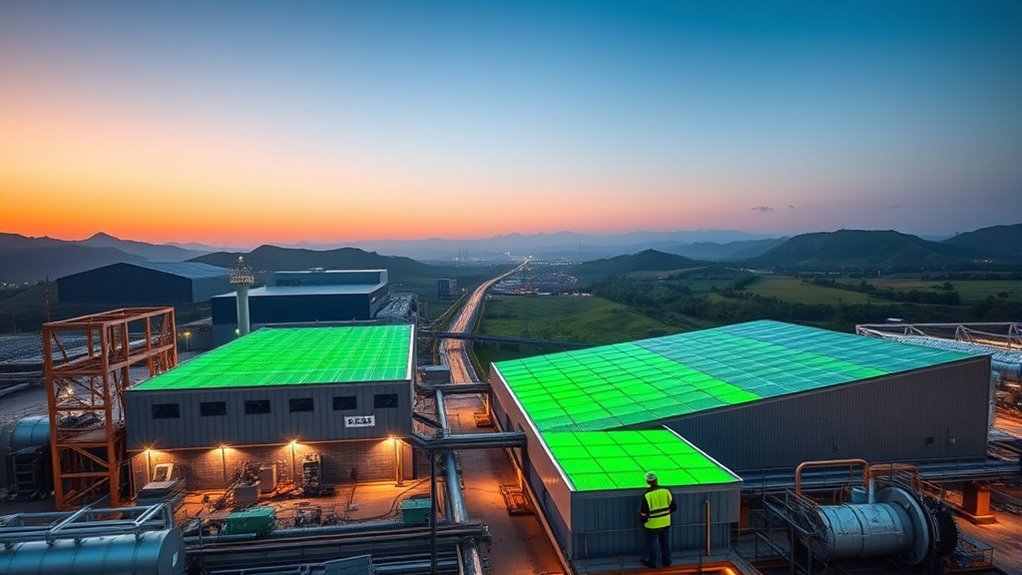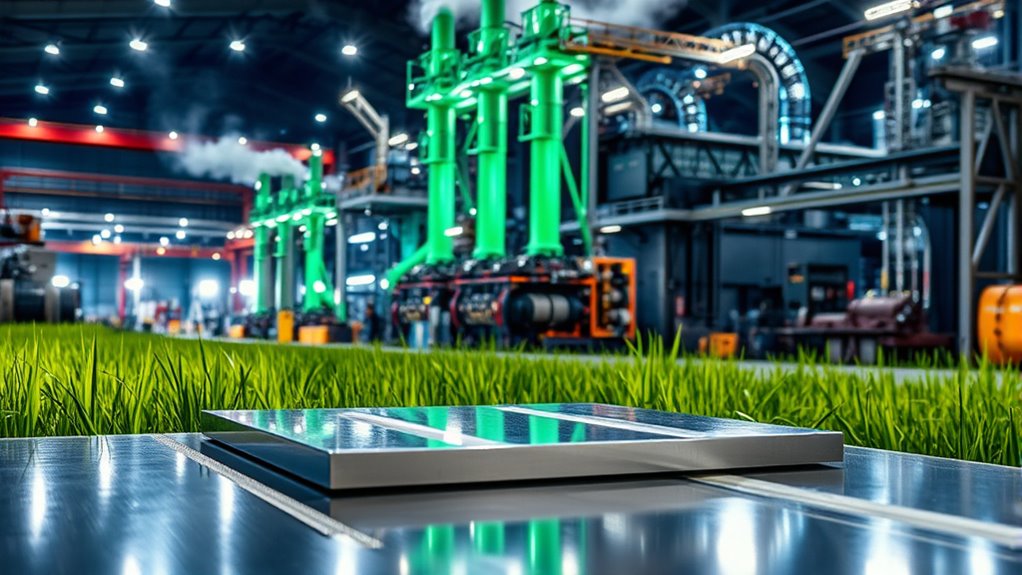Green steel is quickly becoming cost-competitive thanks to falling renewable energy prices, technological improvements, and supportive policies. While initial investments for new facilities or retrofits are high, long-term savings from lower operating costs and greater energy efficiency make it more viable. As renewable energy becomes more accessible and affordable, green steel has the potential to challenge traditional methods. To discover how industry shifts and innovations continue to shape this landscape, keep exploring the latest developments.
Key Takeaways
- Falling renewable energy costs improve green steel’s long-term competitiveness.
- Technological advances in energy storage enhance supply stability and reduce production costs.
- Infrastructure investments and economies of scale lower upfront and operational expenses.
- Policy incentives and consumer demand accelerate adoption and price parity with traditional steel.
- Supply chain innovations and increased renewable capacity support scalable, cost-effective green steel production.

Have you ever wondered how the steel industry is transforming to become more sustainable? The push towards green steel is accelerating, driven by the need to reduce carbon emissions and meet global climate goals. Traditional steelmaking relies heavily on fossil fuels, especially coal, which contributes significantly to greenhouse gases. In contrast, green steel is produced using renewable energy sources like wind, solar, or hydroelectric power. By harnessing renewable energy, the industry can drastically cut its carbon footprint, but it also raises questions about cost and competitiveness. One of the key challenges is integrating renewable energy into existing supply chains. Unlike conventional methods, which are well-established and optimized for cost, green steel production depends on the availability and affordability of renewable energy. This means that steel manufacturers must rethink their supply chain logistics, sourcing, and infrastructure investments to accommodate these cleaner energy sources. Switching to renewable energy isn’t just about changing power sources; it involves building new facilities or retrofitting old ones, which can be capital-intensive upfront. However, the long-term benefits include lower operating costs, especially as renewable energy becomes cheaper and more accessible. This shift also influences the supply chain, requiring closer collaboration with energy providers and suppliers of renewable infrastructure components. As you might imagine, securing a stable supply of renewable energy is vital for maintaining steady steel production and avoiding costly delays. Companies investing in green steel are actively exploring partnerships and innovations to streamline their supply chains, ensuring they can source renewable power reliably and at competitive prices. Additionally, governments and regulators are beginning to support this change with incentives, which can help offset initial costs. Despite these efforts, some skeptics question whether green steel can truly compete on cost, especially in regions where renewable energy is still expensive or less reliable. But as technology advances, economies of scale kick in, and renewable energy prices continue to fall, green steel is becoming increasingly viable. Furthermore, implementing comprehensive SQA Best Practices in the development and deployment of green steel technologies can ensure process efficiency and product quality. Moreover, the cost of renewable energy is a critical factor influencing the overall competitiveness of green steel. As more regions adopt supportive policies, the adoption of renewable energy is expected to accelerate, making green steel more accessible worldwide. Moreover, the evolution of renewable energy technology is rapidly making green steel more feasible and cost-effective. A growing body of research highlights how advances in renewable energy storage could further stabilize supply and reduce costs in the future. In the end, your role as a consumer or industry stakeholder is vital—demand for sustainable products can accelerate the shift and influence supply chain dynamics. Green steel may still face hurdles, but its potential to compete on cost is growing, driven by technological innovation, renewable energy integration, and strategic supply chain shifts. If these trends continue, you’ll see a future where steel production is not just more sustainable but also economically competitive, reshaping the landscape of the global steel industry.
Frequently Asked Questions
How Does Green Steel Impact Global Carbon Emissions?
You see, green steel considerably reduces global carbon emissions by prioritizing renewable sourcing and better carbon accounting. When you support green steel, you’re helping lower the reliance on fossil fuels and decreasing greenhouse gases released during production. This shift encourages industries to adopt more sustainable practices, ultimately leading to cleaner air and a healthier planet. Your choices can drive demand for eco-friendly solutions and promote widespread adoption of low-carbon steel technologies.
What Are the Main Technological Hurdles for Green Steel?
You’re probably thinking green steel’s just a magic fix, but the real hurdles are technological. Hydrogen electrolysis is still expensive and energy-intensive, making it hard to scale. Carbon capture tech isn’t yet perfect, often costly and inefficient. Until these technologies become more affordable and reliable, green steel remains a promising but stubbornly elusive dream, tempting us with a cleaner future that’s just out of reach.
Can Green Steel Meet Industry Quality Standards?
You can be confident that green steel is increasingly meeting industry quality standards, thanks to advancements in sustainable practices and supply chain integration. Manufacturers are refining processes to guarantee durability and strength comparable to traditional steel. As these innovations continue, green steel becomes a viable, eco-friendly alternative, enabling you to adopt sustainable practices without compromising on quality or performance. This progress helps accelerate the shift toward more environmentally responsible steel production.
How Are Governments Supporting Green Steel Development?
You might be pleased to discover that governments are actively nurturing green steel development through policy incentives and smart investment strategies. They’re offering grants, tax breaks, and favorable regulations to encourage innovation and reduce costs. By backing research and infrastructure, they’re creating a welcoming environment for green steel to flourish. These efforts aim to make sustainable steel not just an eco-friendly choice, but also an economically attractive one for industries worldwide.
What Is the Timeline for Green Steel Market Adoption?
You might wonder about the market adoption timeline for green steel. Currently, projections suggest it could gain significant traction within the next 5 to 10 years as costs decrease and demand for sustainable products rises. You should keep an eye on technological advancements and policy changes, as they’ll accelerate adoption. While exact timelines vary, early adoption is expected to grow steadily as industries prioritize environmental responsibility.
Conclusion
If green steel truly becomes cost-competitive, you’ll witness an industrial revolution so monumental, it’ll make the past look like a mere flicker of history. The days of fossil fuel dependence will vanish overnight, replaced by a cleaner, greener future so powerful it could reshape the very fabric of global economies. Brace yourself—this isn’t just a new chapter; it’s an epoch-defining leap into a sustainable era where green steel isn’t just an option, but the unstoppable standard.
Amina brings over a decade of journalism experience to her role as Editor-in-Chief. Under her leadership, Exquisite Post has flourished, maintaining the highest standards of integrity and excellence. Amina’s commitment to truth and her visionary approach guide the editorial team in producing impactful news stories that resonate with our audience.










